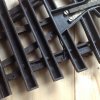When I had my oval of track, no points, set up (apart from the locomotive's own problems), I could run it round fine.
If I then introduce one point but leave the point in the straight through position should I continue to have no problems? I guess it's all about the point!
If I then switch that point will I then get a short?
Sarah Winfield
If I then introduce one point but leave the point in the straight through position should I continue to have no problems? I guess it's all about the point!
If I then switch that point will I then get a short?
Sarah Winfield


